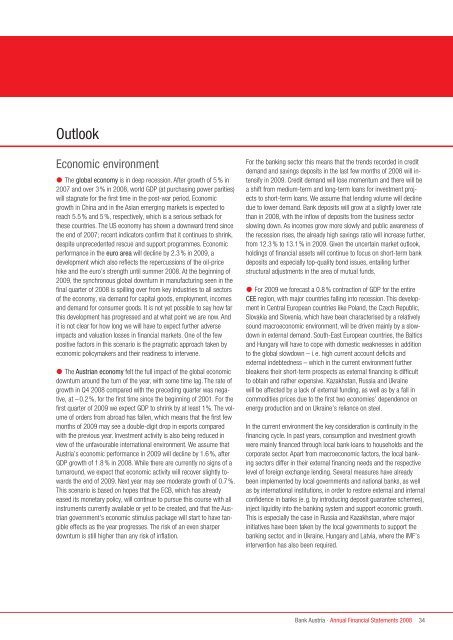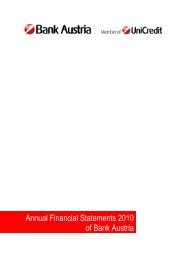Annual Financial Statements 2008 of Bank Austria
Annual Financial Statements 2008 of Bank Austria
Annual Financial Statements 2008 of Bank Austria
You also want an ePaper? Increase the reach of your titles
YUMPU automatically turns print PDFs into web optimized ePapers that Google loves.
Outlook<br />
Economic environment<br />
� The global economy is in deep recession. After growth <strong>of</strong> 5 % in<br />
2007 and over 3 % in <strong>2008</strong>, world GDP (at purchasing power parities)<br />
will stagnate for the first time in the post-war period. Economic<br />
growth in China and in the Asian emerging markets is expected to<br />
reach 5.5 % and 5 %, respectively, which is a serious setback for<br />
these countries. The US economy has shown a downward trend since<br />
the end <strong>of</strong> 2007; recent indicators confirm that it continues to shrink,<br />
despite unprecedented rescue and support programmes. Economic<br />
performance in the euro area will decline by 2.3 % in 2009, a<br />
development which also reflects the repercussions <strong>of</strong> the oil-price<br />
hike and the euro’s strength until summer <strong>2008</strong>. At the beginning <strong>of</strong><br />
2009, the synchronous global downturn in manufacturing seen in the<br />
final quarter <strong>of</strong> <strong>2008</strong> is spilling over from key industries to all sectors<br />
<strong>of</strong> the economy, via demand for capital goods, employment, incomes<br />
and demand for consumer goods. It is not yet possible to say how far<br />
this development has progressed and at what point we are now. And<br />
it is not clear for how long we will have to expect further adverse<br />
impacts and valuation losses in financial markets. One <strong>of</strong> the few<br />
positive factors in this scenario is the pragmatic approach taken by<br />
economic policymakers and their readiness to intervene.<br />
� The <strong>Austria</strong>n economy felt the full impact <strong>of</strong> the global economic<br />
downturn around the turn <strong>of</strong> the year, with some time lag. The rate <strong>of</strong><br />
growth in Q4 <strong>2008</strong> compared with the preceding quarter was negative,<br />
at – 0.2 %, for the first time since the beginning <strong>of</strong> 2001. For the<br />
first quarter <strong>of</strong> 2009 we expect GDP to shrink by at least 1%. The volume<br />
<strong>of</strong> orders from abroad has fallen, which means that the first few<br />
months <strong>of</strong> 2009 may see a double-digit drop in exports compared<br />
with the previous year. Investment activity is also being reduced in<br />
view <strong>of</strong> the unfavourable international environment. We assume that<br />
<strong>Austria</strong>’s economic performance in 2009 will decline by 1.6 %, after<br />
GDP growth <strong>of</strong> 1.8 % in <strong>2008</strong>. While there are currently no signs <strong>of</strong> a<br />
turnaround, we expect that economic activity will recover slightly towards<br />
the end <strong>of</strong> 2009. Next year may see moderate growth <strong>of</strong> 0.7 %.<br />
This scenario is based on hopes that the ECB, which has already<br />
eased its monetary policy, will continue to pursue this course with all<br />
instruments currently available or yet to be created, and that the <strong>Austria</strong>n<br />
government’s economic stimulus package will start to have tangible<br />
effects as the year progresses. The risk <strong>of</strong> an even sharper<br />
downturn is still higher than any risk <strong>of</strong> inflation.<br />
For the banking sector this means that the trends recorded in credit<br />
demand and savings deposits in the last few months <strong>of</strong> <strong>2008</strong> will intensify<br />
in 2009. Credit demand will lose momentum and there will be<br />
a shift from medium-term and long-term loans for investment projects<br />
to short-term loans. We assume that lending volume will decline<br />
due to lower demand. <strong>Bank</strong> deposits will grow at a slightly lower rate<br />
than in <strong>2008</strong>, with the inflow <strong>of</strong> deposits from the business sector<br />
slowing down. As incomes grow more slowly and public awareness <strong>of</strong><br />
the recession rises, the already high savings ratio will increase further,<br />
from 12.3 % to 13.1 % in 2009. Given the uncertain market outlook,<br />
holdings <strong>of</strong> financial assets will continue to focus on short-term bank<br />
deposits and especially top-quality bond issues, entailing further<br />
structural adjustments in the area <strong>of</strong> mutual funds.<br />
� For 2009 we forecast a 0.8 % contraction <strong>of</strong> GDP for the entire<br />
CEE region, with major countries falling into recession. This development<br />
in Central European countries like Poland, the Czech Republic,<br />
Slovakia and Slovenia, which have been characterised by a relatively<br />
sound macroeconomic environment, will be driven mainly by a slowdown<br />
in external demand. South-East European countries, the Baltics<br />
and Hungary will have to cope with domestic weaknesses in addition<br />
to the global slowdown – i.e. high current account deficits and<br />
external indebtedness – which in the current environment further<br />
bleakens their short-term prospects as external financing is difficult<br />
to obtain and rather expensive. Kazakhstan, Russia and Ukraine<br />
will be affected by a lack <strong>of</strong> external funding, as well as by a fall in<br />
commodities prices due to the first two economies’ dependence on<br />
energy production and on Ukraine’s reliance on steel.<br />
In the current environment the key consideration is continuity in the<br />
financing cycle. In past years, consumption and investment growth<br />
were mainly financed through local bank loans to households and the<br />
corporate sector. Apart from macroeconomic factors, the local banking<br />
sectors differ in their external financing needs and the respective<br />
level <strong>of</strong> foreign exchange lending. Several measures have already<br />
been implemented by local governments and national banks, as well<br />
as by international institutions, in order to restore external and internal<br />
confidence in banks (e.g. by introducing deposit guarantee schemes),<br />
inject liquidity into the banking system and support economic growth.<br />
This is especially the case in Russia and Kazakhstan, where major<br />
initiatives have been taken by the local governments to support the<br />
banking sector, and in Ukraine, Hungary and Latvia, where the IMF’s<br />
intervention has also been required.<br />
<strong>Bank</strong> <strong>Austria</strong> · <strong>Annual</strong> <strong>Financial</strong> <strong>Statements</strong> <strong>2008</strong><br />
34
















